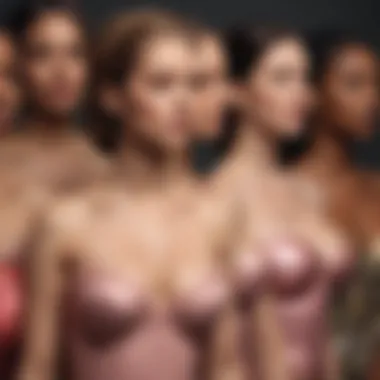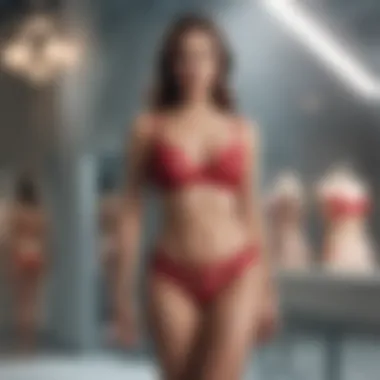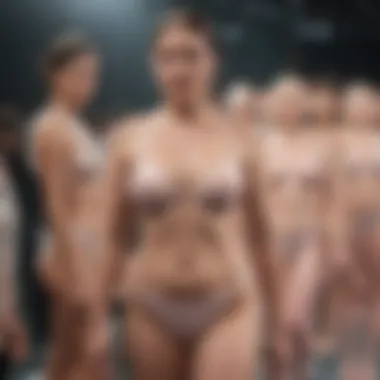The Evolution and Celebration of Women's Breasts


Intro
The perception of women's breasts has undergone significant changes over the centuries. This is not merely a matter of aesthetics; it is intertwined with the threads of culture, politics, and identity. From ancient civilizations that revered the female form to modern-day discussions around body positivity and empowerment, the narrative continues to evolve. Women's breasts have become symbols not just of femininity but also of societal norms and expectations.
Understanding the historical context can provide valuable insight into how we view women's bodies today. This article will explore various facets of this evolution, examining the interplay between fashion trends and societal attitudes toward breasts, while also addressing the complexities tied to health and beauty standards. This analysis seeks to illuminate the celebration of women's breasts beyond mere objectification, recognizing their essential role in the discourse surrounding women's rights and self-acceptance.
Historical Context of Women's Breasts
Understanding the historical context of women’s breasts is crucial for comprehending their evolving role in fashion and society. Women’s breasts have been a significant symbol in various cultures and eras, reflecting societal values, beauty standards, and even political discourses. This section will dissect ancient representations, Renaissance ideals, and Victorian modesty, illuminating how these facets contributed to shaping contemporary perceptions.
Ancient Representations
In ancient cultures, breasts were often celebrated and revered. For instance, within the context of ancient Greece, the goddess Aphrodite represented beauty and fertility. Artistic representations from this era, such as sculptures and pottery, frequently highlighted female breasts, showcasing them as symbols of life and nourishment.
Moreover, cultures like the Egyptians viewed breasts as symbols of motherhood and fertility. Pharaohs often depicted their wives with pronounced breasts in art, emphasizing their beauty and status. This reverence contributed to the idea of breasts as powerful symbols of femininity and societal value, forming a foundation that persists into modern times.
Renaissance Ideals
During the Renaissance, the perception of women's breasts underwent a shift towards a more idealized representation rooted in artistic interpretations. Artists like Botticelli and Titian idealized the female form, often portraying breasts as soft, inviting features that complimented the overall beauty of the body.
The period marked an appreciation for the voluptuous figure, where fuller breasts were synonymous with wealth and health. Fashion evolved as well, with clothing styles that accentuated the bust through corsets and elaborate dresses. Such choices celebrated femininity, showcasing how breasts could be both a source of attraction and a statement of personal identity.
Victorian Modesty
The Victorian era marked a stark contrast to the previous celebration of breasts. This period was characterized by a strong sense of modesty and decorum. Women's bodies, especially their breasts, were often hidden under layers of clothing and tightly laced corsets.
Victorian ideals dictated that femininity was closely tied to morality and virtue. The emphasis shifted from celebration to concealment, as breasts were considered too provocative. This change impacted fashion significantly, promoting styles that emphasized a narrow waist and minimized the visibility of breasts.
In summary, the historical context of women's breasts reveals a profound narrative woven through ancient reverence, Renaissance beauty ideals, and Victorian restraint. Each era not only shaped societal expectations but also influenced how women view their bodies today. Understanding this evolution is essential for appreciating the ongoing discourse regarding body image, empowerment, and personal expression in contemporary society.
Cultural Perspectives on Breasts
Understanding the cultural perspectives on breasts is essential in appreciating their multifaceted roles in society. Across different cultures, breasts have been symbolically and physically significant, influencing notions of beauty, femininity, and social status. These perspectives are not just limited to aesthetics; they encompass deeper social narratives that reflect the values and beliefs of a community.
In the context of this article, exploring various cultural attitudes towards breasts helps in understanding how they have been represented and celebrated over time. This section highlights the importance of recognizing these cultural variations to appreciate the evolving fashion norms and societal expectations surrounding women's bodies.
Western Attitudes
Western societies have traditionally objectified breasts, often viewing them through a sexualized lens. Starting from the Renaissance, where art depicted full-figured women as symbols of fertility, to today’s emphasis on youthful bodies, the portrayal of breasts has often been linked with beauty standards.
Women's breasts have influenced fashion trends significantly. The corset, for example, was designed to enhance and display breasts, reflecting a cultural fixation on their appearance. Over time, the feminist movements have challenged these shallow perceptions, promoting a more holistic understanding of women's bodies.
Despite these efforts, media portrayals and advertising continue to create unrealistic beauty standards. Campaigns by brands like Victoria's Secret have historically reinforced narrow ideals, contributing to body image issues. Therefore, addressing Western attitudes towards breasts encompasses evaluating both historical and contemporary influences on body image and self-perception.
Eastern Views


In many Eastern cultures, breasts can be viewed in a less sexualized manner, often symbolizing motherhood and nurturing. For instance, in countries like India, breasts represent both fertility and the feminine essence. Traditional garments like sarees highlight modesty while embracing the beauty of the female form.
However, there are also expectations placed on women's bodies, which can lead to varying attitudes about beauty and body shape. Some cultures emphasize a fuller figure, where breasts are often seen as a symbol of health and wealth.
Yet, the rising influence of Western media has begun to shift perceptions in some Eastern societies, leading to new standards of beauty that may not align with traditional views. It is crucial to recognize how globalization impacts local beliefs and practices regarding women's breasts to understand this complex relationship fully.
Indigenous Beliefs
Indigenous cultures have their own unique relationships with breasts and femininity. In many Indigenous societies, breasts are celebrated as life-giving and sacred. They are often viewed within the context of community, fertility, and the natural cycles of life.
For instance, certain tribes may have rituals celebrating a woman's coming of age, where the breast symbolizes her transition into womanhood. Such cultures often convey a strong sense of body positivity, honoring diverse body shapes and sizes, which contrasts sharply with mainstream beauty standards.
Understanding these Indigenous beliefs is crucial, as they offer an alternative narrative to the often misrepresented perspectives in Western culture. Access to these authentic representations can encourage a more inclusive discourse surrounding women's bodies, emphasizing respect and appreciation for diverse forms of femininity.
Fashion and Representation
The relationship between fashion and the representation of women's breasts serves as a critical lens through which one can investigate cultural ideals and societal norms. Breasts have always held a prominent position in fashion, from lingerie to dresses and modern trends. This significance is not merely aesthetic; it informs identity, self-worth, and empowerment.
The Role of Lingerie
Lingerie has evolved from a functional garment to a complex expression of femininity. It plays a huge role in how women perceive their bodies and how society views them. Historically, lingerie aimed to enhance the breast shape while maintaining modesty. For instance, corsets of the Victorian era constricted the waist to accentuate the bust, emphasizing the traditional ideals of beauty. In contrast, contemporary lingerie often focuses on comfort and empowerment, encouraging women to embrace their natural bodies.
Moreover, brands like Victoria’s Secret and Savage X Fenty have contributed to a broader dialogue by promoting diversity in their advertising campaigns. Many women now seek lingerie that represents their uniqueness rather than conforming to a one-size-fits-all approach. This shift reflects the growing demand for individuality and authenticity in fashion.
Dresses and Silhouettes
Dresses have continually played a pivotal role in shaping perceptions of femininity. The silhouette of a dress can accentuate or downplay breasts, indicating societal attitudes towards women's bodies. Early 20th-century fashion, with its hourglass silhouettes, highlighted curvaceous figures as the ideal. In contrast, the liberation movements led to a more relaxed fit in the 1960s and 1970s, promoting comfort and rejecting restrictive norms.
Today, fashion encompasses a plethora of silhouettes that cater to diverse body types. Designers are increasingly embracing inclusive fashion, showcasing a variety of cuts and styles rather than rigid standards. This change allows women of all shapes and sizes to express their femininity without the constraints imposed by past ideals.
Modern Fashion Trends
Modern fashion trends have redefined how women celebrate their bodies, integrating inclusivity and sustainability into their core philosophies. Brands now actively address the diverse representation of breasts, promoting styles that fit various shapes and sizes. This paradigm shift encourages women to celebrate their individuality rather than adhere to narrow beauty standards.
Key trends include:
- Size Inclusivity: A significant number of brands offer larger size ranges, promoting body positivity.
- Comfort over Conformity: Many women now prioritize comfort, opting for styles that do not restrict movement.
- Sustainable Choices: With an increased awareness of environmental issues, many brands focus on sustainable materials, allowing women to feel good about their fashion choices.
"Fashion should not only celebrate women's bodies but also respect their individuality and choices."
The Intersection of Health and Aesthetics
The intersection of health and aesthetics concerning women's breasts is a critical aspect to explore. This part highlights how societal views on beauty can greatly influence women's health choices and self-image. The focus on aesthetics often places pressure on women to conform to idealized body standards. However, it is vital to note that health should not be compromised in the pursuit of these standards. A balanced understanding of how beauty ideals shape health decisions is necessary.
Body Positivity Movement
The body positivity movement seeks to challenge conventional beauty standards that often marginalize diverse body types. This movement embraces all shapes and sizes, encouraging women to love and accept their bodies unapologetically. The narrative shifts from achieving a certain aesthetic to valuing health and self-care.


- Advantages of the body positivity movement include:
- Promoting mental well-being through self-acceptance.
- Encouraging a healthier relationship with food and exercise.
- Fostering a sense of community among women.
Despite its advances, the movement still faces criticism. Some argue that it may promote neglect towards health. Nevertheless, it plays a crucial role in redefining how beauty is perceived by focusing on diverse representations in media and society.
Breast Health Awareness
Raising awareness about breast health is essential, especially in a society influenced by beauty norms. Regular health checks and understanding of one’s own body are vital. This involves knowledge about the physical changes that can occur and recognizing warning signs for potential issues. Breast cancer, for instance, is a significant concern that emphasizes the necessity of awareness and education.
Key elements include:
- Educating women about self-exams and screenings.
- Encouraging discussions around genetic risks.
- Promoting access to healthcare resources.
The intersection of health literacy and societal ideals can empower women to take proactive steps towards their health, which can positively influence their self-image.
Surgery and Enhancements
The conversation about breast surgery, whether cosmetic or reconstructive, adds another layer of complexity. Many women want to modify their bodies to align with personal aesthetic desires. Some may choose augmentation to enhance their appearance. In contrast, reconstructive surgery often addresses health issues following procedures like mastectomies.
It's important to consider the motivations behind surgical choices. Factors can include:
- Personal empowerment through self-expression.
- Societal pressures to conform to ideal body images.
- Medical necessity due to health concerns.
Women should approach such decisions with thorough understanding and consideration of the risks involved along with the emotional implications. Each individual should navigate their choices reflecting their unique values and beliefs, ensuring health remains a priority.
"The way women's bodies are viewed in society can either promote health or negatively impact it, making awareness and education vital components of personal agency and empowerment."
Through examining these intersecting aspects of health and aesthetics, it becomes clear that women’s breasts are not only symbols of femininity but also important to health narratives. Understanding this connection is vital for fostering a society that respects individual choices while promoting well-being.
Empowerment Through Personal Style
The topic of empowerment through personal style is crucial in understanding how women's breasts have been represented and celebrated in fashion and society. Personal style enables women to express their individuality, confidence, and identity. In a world where societal norms often dictate standards of beauty, developing a personal style that resonates with one's own values is essential. This empowerment can manifest in many forms, from choosing clothing that flatters one's body type to adopting trends that align with personal taste and comfort.
Choosing the right outfit plays a significant role in this empowerment journey. When women wear clothing that makes them feel confident and comfortable, they project self-assurance to the world. This confidence can influence not only personal interactions but also professional opportunities. Furthermore, dressing in a manner that aligns with authentic self-expression allows women to reclaim their bodies and assert their presence in spaces where they might feel overlooked or underestimated. This is especially relevant in discussions surrounding body positivity and acceptance.
Additionally, embracing diversity within personal style is equally important. Fashion has evolved to include a wide range of body types, colors, and styles, moving past the conventional beauty standards of the past. Women can now celebrate differences rather than conform to a single narrative. Brands and designers increasingly recognize the importance of inclusivity, creating collections that reflect varied tastes and body shapes.
"Fashion should be a means of self-expression and empowerment, not a tool for conformity."
Choosing the Right Outfits
Selecting the right outfits is essential for feeling empowered and confident. Each woman has unique tastes and preferences, and finding clothing that reflects these qualities can enhance self-esteem. When choosing outfits, women should consider the following:
- Fit and Comfort: Clothing should fit well and feel comfortable. This not only affects how one looks but also how one feels.
- Style: Identify personal styles that resonate, whether it is casual, formal, or eclectic. The right style can convey confidence and personality.
- Occasion: Outfits should fit the context. Being appropriately dressed for an occasion boosts confidence.
- Colors and Patterns: Different colors evoke different emotions. Understanding what colors flatter and what makes one feel good is crucial.
- Layers: Layering can enhance outfits and allow for versatility. It can be a practical way to adapt to different environments.


Embracing Diversity
Embracing diversity in personal style is fundamental to empowerment. It fosters an inclusive environment where all body types and styles are celebrated. This diversity redefines beauty standards, allowing women to see themselves in fashion without feeling pressured to conform. Here are some aspects of embracing diversity:
- Body Positivity: Recognizing that beauty comes in various shapes and sizes encourages women to appreciate their bodies.
- Cultural Representation: Fashion that incorporates cultural elements allows diverse backgrounds to be celebrated.
- Variety in Brands: There is a growing number of brands catering to different body types and styles. Supporting these brands supports inclusivity in fashion.
- Social Media Influence: Platforms like Instagram and TikTok have given rise to a wide array of fashion influencers who celebrate diversity and inspire others to express themselves freely.
Media Influence on Beauty Standards
The portrayal of women's breasts in media has a profound effect on societal perceptions of beauty and femininity. This influence extends to various formats such as advertising, television, film, and more recently, social media platforms. Each medium shapes and reshapes standards of what is considered desirable or attractive, often at the expense of diverse representations.
Media sets benchmarks that not only reflect existing beauty ideals but also multiply their reach. This is vitally significant because it establishes norms that women often feel pressured to conform to. Broadly speaking, beauty standards depicted in media can lead to feelings of inadequacy for many women, especially when these standards do not celebrate the variety found in real bodies.
Advertising and Marketing
Advertising plays a critical role in shaping beauty standards, often using women's breasts as focal points in marketing campaigns. From lingerie ads to fashion showcases, the visual emphasis on breasts serves various commercial purposes that enhance attraction and desirability.
- Visual Appeal: Advertisements target the viewer's attention with images designed to be captivating. This strategy often results in a narrow representation of beauty, which can lead to unrealistic expectations.
- Product Association: Breast representations in advertising are not only about beauty but also about associating products with desirability. Brands like Victoria's Secret epitomized this strategy, with campaigns centered around glamorizing women's bodies as a vital component of their marketing message.
- Cultural Impact: This portrayal influences women's self-perceptions and body images. They might feel compelled to alter their appearances to fit these ideal representations, leading to a cycle of dissatisfaction and attempts at achieving those standards.
Overall, while advertising can be a powerful tool for empowerment, it often perpetuates limited and unrealistic beauty ideals that require reevaluation.
Social Media Impact
The advent of social media introduced a new layer to the discourse on beauty standards. Platforms like Instagram or TikTok allow for immediate sharing and influencer marketing, which reshapes perceptions at a rapid pace.
- Accessibility to Diverse Representation: Unlike traditional media, social media provides a space for diverse body types to be celebrated. Users can share their own narratives, offering alternate views to the mainstream portrayals found in conventional advertisements.
- Influencer Marketing: Influencers have a unique avenue to shape perceptions about beauty. They often curate content that includes personal experiences related to body image, which resonates more authentically with their audiences than traditional media does.
- Potential for Harm: Despite the positives, social media can also amplify negative body image issues. The infinite scroll of seemingly perfect images can lead individuals to unfavorable comparisons with themselves.
"Through proactive engagement with various voices and experiences, social media has the potential to challenge and redefine beauty standards."
Future Trends in Fashion
The realm of fashion continuously evolves, reflective not only of aesthetic preferences but also of broader societal shifts. The importance of discussing future trends in women's fashion is evident when considering how cultural attitudes towards women's breasts have changed over time. This section delves into anticipated developments that fashion may embrace, focusing on sustainability and inclusivity. These trends are not just about style; they also represent a commitment to respecting and empowering women's diverse bodies.
Sustainable Practices
Sustainability in fashion is no longer just a buzzword; it is becoming an essential practice. The shift towards environmentally-friendly materials and production is crucial in addressing the detrimental effects of fast fashion. Brands are evolving to include recycled and organic fabrics, which reduce waste and minimize carbon footprints. This shift is relevant for women's breasts in fashion, as many items like bras and swimwear can utilize sustainable methods easily.
Some key elements surrounding sustainable practices include:
- Material Choices: Selecting organic cotton, Tencel, or recycled polyester can significantly decrease environmental impacts.
- Ethical Manufacturing: Brands that maintain ethical practices throughout their labor supply chain reflect a growing demand for fairness and respect.
- Longevity Over Quantity: Promoting pieces designed to last rather than to be discarded aligns with changing consumer desires for quality.
As awareness of climate change rises, consumers are more likely to support brands that align with their values. This conscientious approach boosts the importance of comfort and fit, especially concerning lingerie and other garments that celebrate and accommodate broader physical diversity.
Adaptation to Diverse Bodies
The future of fashion is also marked by a commendable shift towards inclusivity. Embracing diverse body shapes transcends size, including different anatomical features, as women of all shapes deserve representation. Rather than adhering to one-size-fits-all trends, the industry is learning to embrace the unique physiques of women. This is paramount in regards to women's breasts, which exhibit a wide array of shapes and sizes.
Several aspects to consider about adaptation to diverse bodies include:
- Customizable Fits: Fashion brands are embracing adjustable designs in their clothing lines, allowing women to find the right fit for their unique body structures.
- Diverse Model Representation: Moving away from traditional beauty standards, brands showcase models of all body types, which invites women to see themselves in the fashion being presented.
- Body Positive Campaigns: The voice of body positivity is stronger than ever. Campaigns that celebrate all shapes aim to battle the stigma often associated with certain body types, fostering a culture of acceptance.
To succeed, the fashion industry must prioritize the female form in all its variations. Diversity in marketing, product lines, and even runway shows would not only celebrate inclusivity but could also pave the way for more women to feel confident and empowered.
In summary, the future trends in fashion are about more than just upcoming styles; they signify a transformative shift in how women's bodies, and specifically their breasts, are understood and represented within the industry. The focus on sustainable practices and the adaptation to diverse bodies underscores the importance of inclusivity and environmental mindfulness in shaping the forthcoming landscape of women's fashion.



